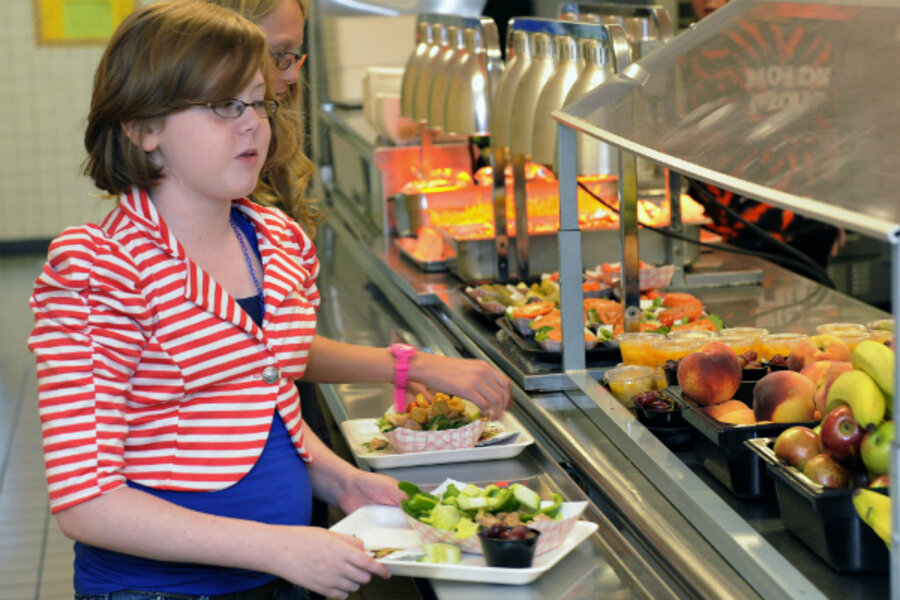Tear down this vending machine: US proposes school snack rules
Loading...
| Washington
The government for the first time is proposing broad new standards to make school snacks healthier, a move that would ban the sale of almost all candy, high-calorie sports drinks and greasy foods on campus.
A study last year remarked that school snacks are a national security threat. The Christian Science Monitor's Modern Parenthood blog reported:
"More than 90,000 tons of junk food are being sold in American schools every year, is more than the weight of the aircraft carrier Midway.... former military leaders – including Richard Myers, the former Chairman of the Joint Chiefs of Staff ,and James M. Loy, former Deputy Secretary of Homeland Security – called today for school districts to limit the sale of junk food and for national legislation to enforce those limits and to fund better school lunch options that are more appealing while still being nutritious.
'This is not a spectator sport. It’s a team sport, a contact sport and we need parents on the team, but the reality is that kids are getting 40-50% of their calories in school daily,' Charles E. Milam, Acting Deputy Assistant Secretary of Defense for Military Community and Family Policy said at the organization’s release of the report in Washington today."
Under new rules the Department of Agriculture proposed Friday, school vending machines that once were full of Skittles and Sprite would instead be selling water, lower-calorie sports drinks, diet sodas and baked chips. Lunch rooms that now sell fatty "a la carte" items like mozzarella sticks and nachos would have to transition to healthier pizzas, fruit cups and yogurt.
The rules, required under a child nutrition law passed by Congress in 2010, are an effort to combat childhood obesity. While many schools have already made improvements in their lunch menus and vending machine choices, others are still selling high-fat, high-calorie foods.
The USDA is proposing fat, calorie, sugar and sodium limits on almost all foods sold in school. Current standards regulate only the nutritional content of school breakfasts and lunches subsidized by the federal government. Snacks would have to be less than 200 calories, and elementary and middle schools could only sell water, low-fat milk or 100 percent fruit or vegetable juice. High schools could sell some sports drinks, but the calories would be limited.
"Parents and teachers work hard to instill healthy eating habits in our kids, and these efforts should be supported when kids walk through the schoolhouse door," said Agriculture Secretary Tom Vilsack.
The new standards will cover vending machines, "a la carte" lunch lines and any other foods regularly sold around school. The proposed rules would not cover in-school fundraisers or bake sales, though states could decide to individually regulate those. The guidelines do not apply to after-school concessions at school games or theater events, goodies brought from home to celebrate a birthday, or anything a student brings for their own personal consumption.
The new rules would be one of many recent changes to the school lunch program to make foods healthier. Nutritional guidelines for the subsidized lunches were revised last year and put in place last fall. The 2010 child nutrition law also provided more money for schools to serve free and reduced-cost lunches and required more meals to be served to hungry kids.
Last year's rules faced criticism from some conservatives, including some Republicans in Congress, who said the government shouldn't be telling kids what to eat. Mindful of that backlash, USDA exempted in-school fundraisers and proposed different options for some parts of the rule, including the calorie limits for drinks in high schools, which would be limited to either 60 calories or 75 calories in a 12 oz. portion.
Schools, industry, interest groups and any critics of the proposal will have 60 days to comment and suggest changes, before the USDA writes the final rule. The soonest the rules could be in place would be the 2014 school year.
Margo Wootan, a nutrition lobbyist for the Center for Science in the Public Interest, says surveys done by her organization show that most parents want changes in the lunchroom.
"Parents aren't going to have to worry that kids are using their lunch money to buy candy bars and a Gatorade instead of a healthy school lunch," she said.
The food industry has been mostly on board with the changes, and several companies worked with Congress on the child nutrition law two years ago. Major beverage companies have already agreed to take the most caloric beverages out of school vending machines.





